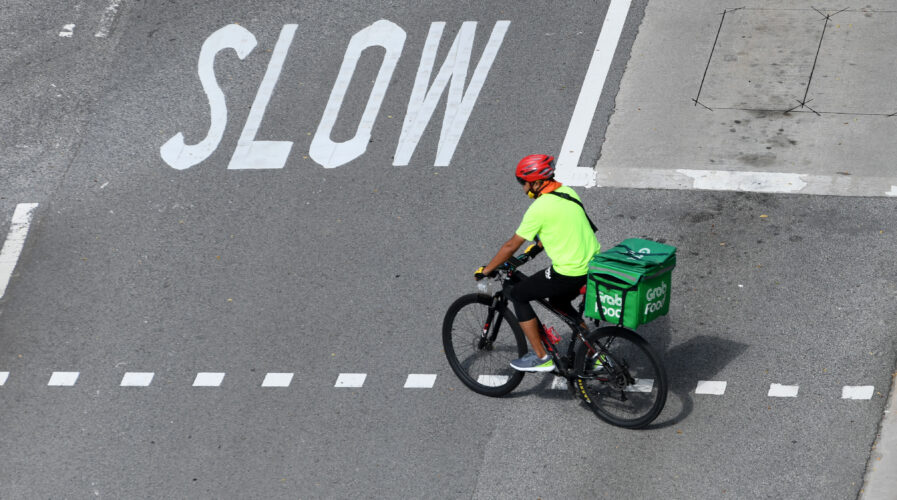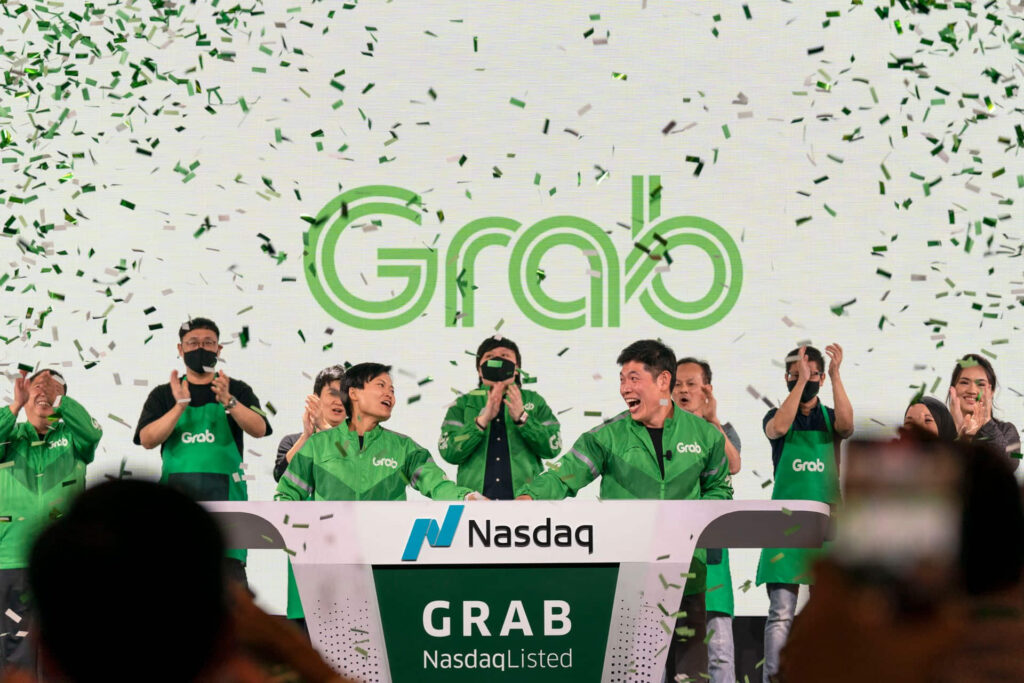
Can e-hailing giant Grab reverse out of red and break even by 2H24?PIC: A Grab delivery cyclist rides across a junction in Singapore on April 20, 2020, as the number of food deliveries has surged since stay at home restrictions were put in place to halt the spread of the COVID-19 coronavirus. (Photo by ROSLAN RAHMAN / AFP)
Can Grab hit the slab of profitability in 2024?
- Grab has been struggling since it went public through a merger with a special purpose acquisition company in December last year.
- Now, it expects revenue to slow sharply still since its ride-hailing operation has yet to fully recover.
- The Southeast Asian tech giant targets profitability in 2024 and it is speeding up efforts to reverse years of losses, while expecting to grow by 45% to 55% next year.
Once known as the rising star of Southeast Asia, Grab Holdings Inc has slowly been inching away from its prominence — given the rise of strong regional competitors as well as its faltering ride-hailing business since the pandemic. Frankly, Grab has been racking up losses since its founding and has yet to prove it can reach profitability. The Singapore-based tech giant has even been struggling to gain a steady footing since it became a publicly listed company in the US last December.
Yet, Grab is certain that it can reach break-even in the next 21 months — or at least that was what investors were told earlier this week during the company’s first investor day. In fact, the company said it anticipates breaking even in the second half of 2024 on a conditional basis, and excluding one-time items. Grab also forecasted a 45% to 55% increase in growth for 2023, in its attempt to try and reassure shareholders of its rebound.
The growth forecast is actually much slower than anticipated but it is Grab’s attempt to adjust to the market downturn and speedup efforts to reverse several years of losses. The Southeast Asian tech giant, which counts Japan’s SoftBank and Uber Technologies Inc. as two biggest shareholders, expects losses to narrow to US$380 million on an adjusted basis in the second half of this year. All while it holds US$6 billion of cash and liquid items on hand, giving it time to turn its on-demand and fintech services around.
For context, the Singapore-based superapp is counting on turning around its loss-making delivery and financial-services businesses to hit its profit target. Prior to this week’s forecast, it previously expected its deliveries division would get into the black by the second quarter of next year, when it should have margins of at least 3%. But why is Grab, once Southeast Asia’s most valuable startup, struggling to convince investors of their money making potential after staging their stock-market debut in recent months?
Grab made the world’s biggest SPAC deal but at what cost?
Grab, which operates in 480 cities across eight countries in Southeast Asia including Indonesia, Thailand and Singapore, has long been a barometer of consumer tech sector health in the region. The company started out in ride-hailing and expanded into banking, lending, grocery delivery and hotel bookings, among other services.
In all honesty, even after a decade of operations, Grab has struggled since it went public through a merger with a special purpose acquisition company in December 2021. Its share price has plunged over the last nine months, sending its share price down by 61% over the year to date. Grab, which went public by merging with Altimeter Capital Management’s SPAC in what was originally a US$40 billion deal, is now worth about US$10.8 billion.

Anthony Tan and Tan Hooi Ling, co-founders of Grab, were joined onstage in Singapore during the opening bell ceremony at Nasdaq.
Source: Grab
The stark reality is that Grab’s fortunes have ebbed and flowed along with Covid-19 infection rates and restrictions, which affect demand for rides and meal deliveries. Its CEO Anthony Tan’s vision of creating a so-called superapp for Southeast Asia was aggressive, but led to extensive losses. Grab lost US$3.4 billion in 2021 and has piled up almost US$1 billion of losses in the first two quarters of this year.
“Looking ahead, we’re firing on all cylinders to improve our profitability trajectory,” Tan said at the event in Singapore on Tuesday. “Grab is trying to achieve this by growing our top line in a sustainable manner.” Separately, Grab’s COO Alex Hungate, in an interview with The Financial Times in Singapore said that they are “expecting the environment to remain tough. We want to be the largest, most efficient on demand platform in Southeast Asia. We are a single app for the consumer, but we are not doing everything for the consumer,” he added.
What’s ahead?
For Tan, “ten years and ten billion journeys later”, he reckons the company has barely scratched the surface in their mission to drive Southeast Asia forward. “We believe there is a huge runway of growth ahead of us in serving this region and we are well positioned with our resources to capitalize on the vast opportunities. We plan to leverage the power of the superapp ecosystem as a competitive moat to strengthen our leadership in the region, even as we continue to optimize our costs,” he added in a statement.
That said, among key growth initiatives announced during its first investors day include expanding its monthly subscription platform, GrabUnlimited which is now in five countries including Indonesia, Malaysia, Singapore, Thailand and the Philippines. Currently, average GrabFood GMV from GrabUnlimited subscribers is 2.4 times higher than from non-subscribers, with subscribers also transacting 2 times more on average compared to non-subscribers.
Grab has also recently entered a strategic partnership and investment into one of Indonesia’s largest hypermarket chains, PT Trans Retail. The partnership aims to reduce Grab’s operating costs and accelerate the expansion of on-demand grocery delivery by leveraging Trans Retail’s vast retail footprint, warehousing capabilities, and purchasing power.
Separately, Grab so far expects its digital bank operation in the region, run with Singapore Telecommunications Ltd., to break even only by 2026 — a rather ambitious move as well, considering the majority of digital banks around the world are struggling to reach profitability. Overall, it would definitely be a long road ahead for Grab, factoring in the economic conditions in the region it is operating in and the strong foothold of its competitors especially Indonesia’s GoTo.
READ MORE
- Safer Automation: How Sophic and Firmus Succeeded in Malaysia with MDEC’s Support
- Privilege granted, not gained: Intelligent authorization for enhanced infrastructure productivity
- Low-Code produces the Proof-of-Possibilities
- New Wearables Enable Staff to Work Faster and Safer
- Experts weigh in on Oracle’s departure from adland


